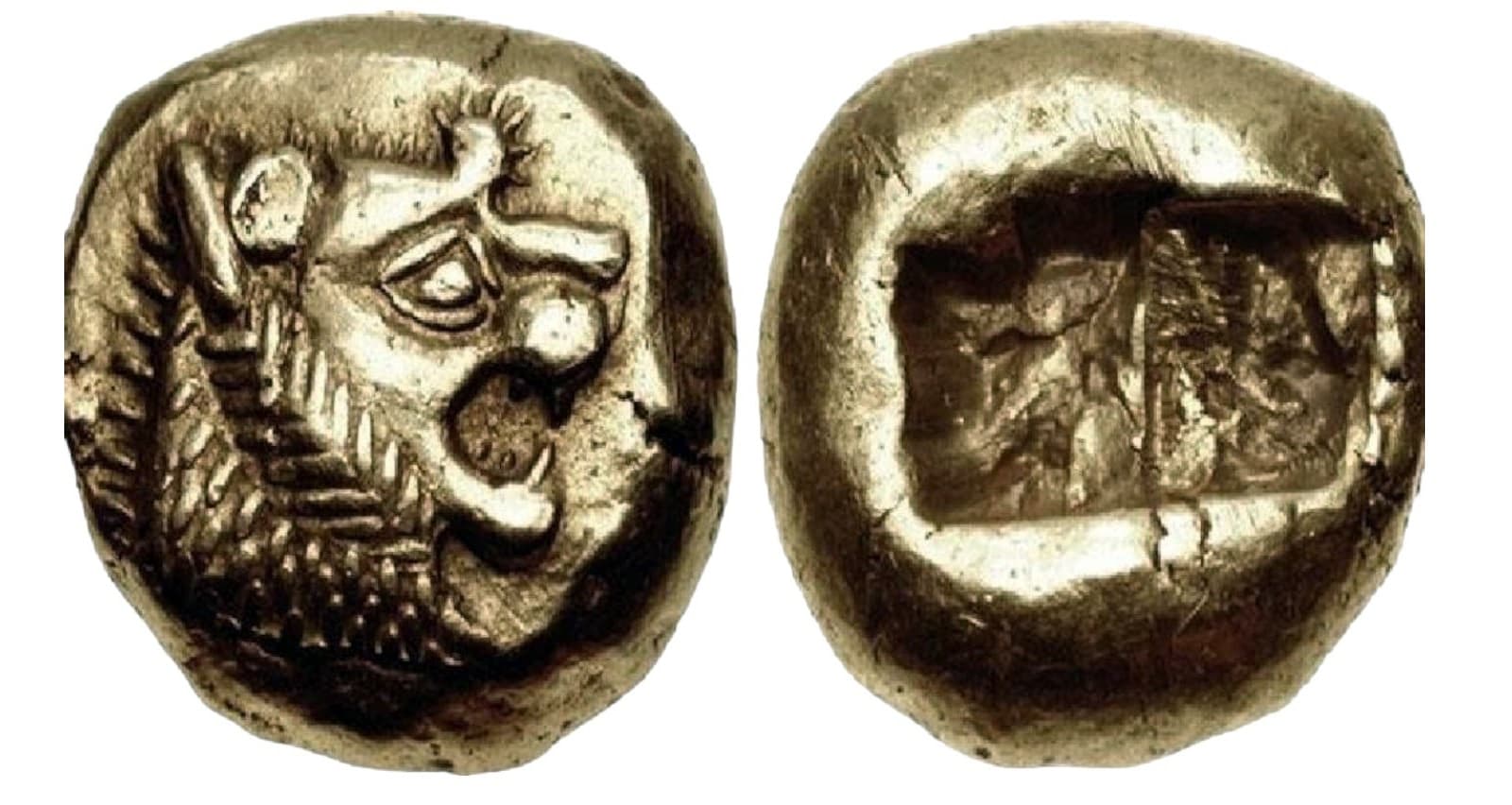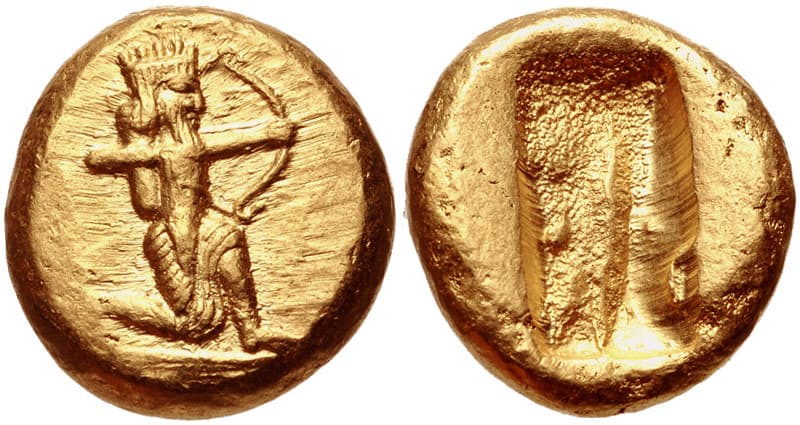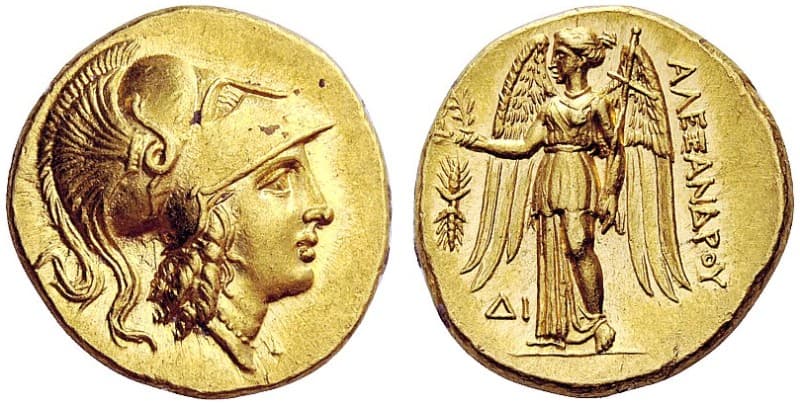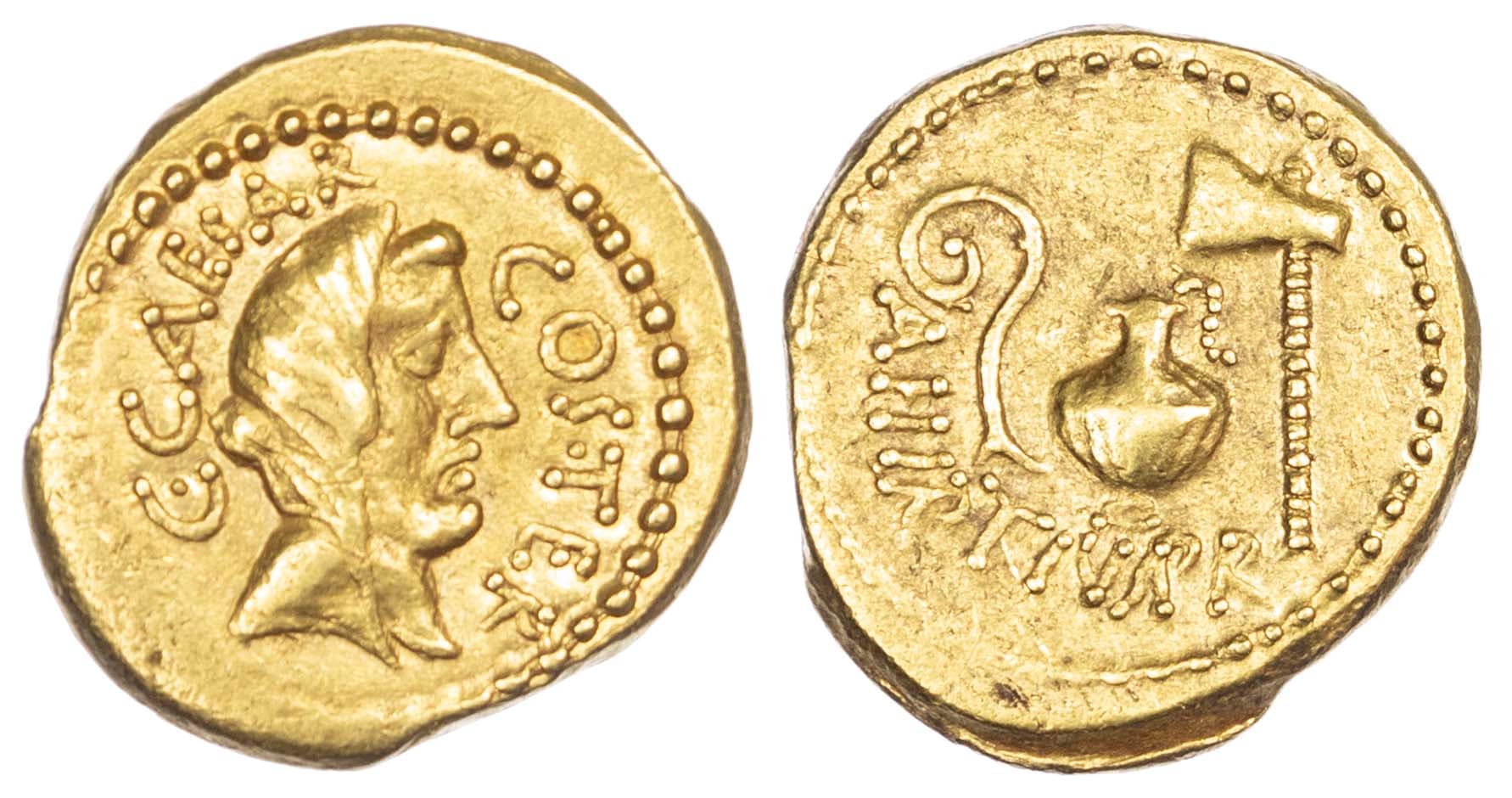5 Ancient Gold Coins Worth a Fortune Today
These five coins, some of the earliest ever struck, are prized for their scarcity, historical importance, and the sheer beauty of their designs. Whether flashing the fierce lion of Lydia or the poised portrait of Emperor Constantine, each of these coins commands eye-watering sums at auction and remains a tangible link to the dawn of civilization.
Lydian Lion (also called Croeseid)
Image: Original Lydian Lion coin from the early 6th century BC.The Lion Stater, often called the Lydian Lion, was minted around 600 BC under the rule of the Mermnad dynasty in the ancient kingdom of Lydia, located in what is now western Turkey. Lydia was renowned for its rich deposits of electrum, a natural alloy of gold and silver, which gave the region both wealth and the raw materials for pioneering coinage. This innovation marked the first time a government officially issued standardized metal coins, transforming the way people traded goods and services.
Each Lion Stater typically weighed about 8.1 grams and featured a bold, stylized lion's head and forepart stamped with a simple punch, a technique that guaranteed the coin's weight and purity. The choice of the lion motif symbolized strength and royal authority, reflecting the power of the Lydian kings who commissioned the coin.
The striking design and reliable value of the Lion staters set a standard that neighboring regions quickly adopted, spreading the concept of coinage throughout the ancient Near East and into the Greek world. Over the next centuries, Greek city-states refined the practice, introducing silver drachmas and various designs, but they all traced their origins back to those early Lydian coins.
Today, surviving Lion staters are rare treasures in museums such as the British Museum and the American Numismatic Society, where they offer a tangible link to the dawn of money. On the private market, well-preserved examples can fetch hundreds of thousands of dollars at auction, prized by collectors for their historical significance and striking imagery.
Persian Daric (also called Daric Siglos)
Image: Type II Persian Daric (AV, 14mm, 8.32g) featuring the iconic “king shooting arrow” design. Minted circa 505-480 BC during the reign of Darius I to Xerxes I.The Persian Daric was first struck by Darius I around 520 BC as part of a new, unified monetary system for the Achaemenid Empire, quickly becoming the bullion backbone of Persia's vast territories.
Each Daric bore a stylized king-archer motif showing the monarch poised to shoot a bow and arrow, an image symbolizing royal power and martial prowess. The coins maintained an exceptionally consistent standard weight of about 8.4 grams and gold purity of approximately 95.8 percent, making them one of the most reliable currencies of the ancient world.
Darics functioned alongside silver “sigloi” in a bimetallic system that facilitated international trade and military pay, one Daric equaled twenty silver siglos, and hoards have been unearthed from Sicily to Afghanistan. They are even mentioned in the Old Testament (eg. I Chronicles 29:7; Ezra 2:69; Nehemiah 7:72), underscoring their widespread recognition and value.
Today, Darics are prized by collectors, and particularly fine examples, or rare “double Darics”, can command six-figure sums at auction.
Macedonian Gold Stater (also called Alexander Stater)
Image: Gold stater of Alexander the Great, struck around 323 BC at the Memphis mint.The Macedonian gold stater was a small, shining coin that changed how rulers used money to tell their story. Before Alexander the Great, coins usually showed gods, symbols, or idealized images rather than personal portraits. Around 336 BC, Alexander's face, youthful and crowned with the horns of Zeus-Ammon, began appearing on coins. While not the first ruler to ever appear on a coin, this was an important early example of a king using his image as a powerful symbol of authority and divine favor across his vast empire.
Weighing about 8.6 grams and made of nearly pure gold, these staters circulated widely across the vast empire Alexander the Great conquered, from Greece to Egypt and into Asia. They were carried by soldiers, traders, and diplomats, spreading a consistent royal image far and wide. On the obverse, these coins typically feature the helmeted head of Athena, the Greek goddess of wisdom and war, symbolizing strength and protection.
The reverse usually depicts Nike, the goddess of victory, standing with a wreath and stylis in hand, symbols of triumph and authority. This design emphasized Alexander's military success and divine favor.
Over time, as new cities were founded and mints opened throughout the empire, local variations appeared, but the core imagery of Athena and Nike remained remarkably consistent. Today, these gold staters are prized by collectors not only for their beauty but for their rich historical significance, capturing the spirit of an empire forged by one of history's greatest conquerors.
Roman Aureus of Julius Caesar (also called Caesar Aureus)
Image: Gold aureus of Julius Caesar, minted in 46 BC by A. Hirtius in Rome. Obverse: veiled head of Vesta. Reverse: emblems of the augurate and pontificate.The aureus was the main gold coin of ancient Rome, struck from the late 1st century BCE until the early 4th century CE and derived from the Latin word for gold, “aurum”. It was originally worth 25 silver denarii, Rome's standard silver coin, making it a high-value piece used mainly for large payments and state expenses. Before Julius Caesar, gold coins were issued only sporadically during emergencies; Caesar's reign marked the first major, systematic minting of the aureus as he tapped Rome's vast war treasures to fund his campaigns and pay his legions.
Each Julius Caesar aureus typically weighs about 7.9 grams and measures roughly 20 millimetres across, almost identical in size to the silver denarius, but heavier because gold is denser than silver. Coins struck in 46 BCE often bear the legends “C·CAESAR” on the obverse and “A·HIRTIVS·PR” on the reverse, honoring the praetor Aulus Hirtius who oversaw the minting in Rome.
What makes these aurei truly revolutionary is that they feature the first realistic portrait of a living person, Julius Caesar himself, breaking with centuries of tradition that reserved coin imagery for gods or symbolic figures. Caesar's decision to place his own likeness on gold coins was a bold act of personal propaganda, signaling his authority and divine favor to every recipient across the Republic.
Because so few genuine Julius Caesar aurei have survived, especially those struck during his lifetime, they are among the most coveted of all ancient coins.
Byzantine Solidus of Constantine I (also called Nomisma)
Image: Gold solidus (nomisma) struck under Emperor Constantine the Great at the Antioch mint around 324-325 AD.In the early 300s AD, Emperor Constantine I introduced a brand-new gold coin called the solidus, or nomisma, as a replacement for the old aureus. Each solidus weighed about 4.45 grams and was struck from nearly pure gold, a level of consistency and quality that set a standard lasting over seven centuries.
The obverse of the solidus usually shows Constantine's bust, helmeted or diademed, holding symbols of authority. Many coins bear the famous “M/G” mintmark, identifying them as products of the Constantinople mint. On the reverse, you'll often see a standing figure of Victory or an emperor on horseback, carefully detailed despite the coin's small 20 mm diameter.
Remarkably, the solidus remained almost unchanged in weight and purity from its introduction until the 11th century, surviving the fall of the Western Roman Empire and becoming the backbone of Byzantine finance. Its stability helped it spread across Europe and the Mediterranean, influencing later coins such as the Islamic dinar and the Russian zolotnik.
Today, solidi are prized by collectors and museums for their historical importance and beautiful craftsmanship. High-grade examples with sharp relief and clear mintmarks can command high prices.




